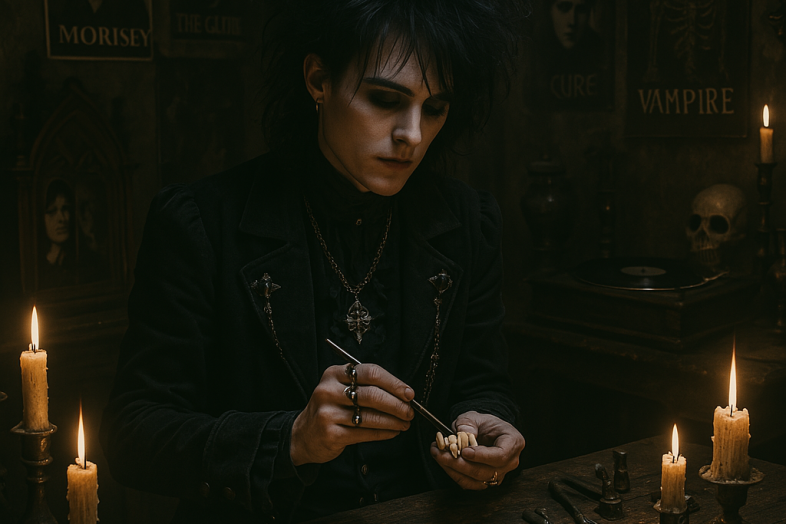
The Art and Craft of Fangsmithing: A Deep Dive into the World of Fangsmiths
In the world of unique, subcultural fashion and body adornment, one often-overlooked but fascinating profession is that of the fangsmith. Fangsmiths are artists and craftsmen (and women) who specialize in creating realistic and fantastical dental prosthetics, often in the form of fangs. While this niche profession may seem to have sprung directly from the rise in vampire fandom, goth culture, and fantasy role-playing, the art of fangsmithing is steeped in both historical and modern influences, blending dentistry, craftsmanship, and pop culture into a truly unique craft.
We will explore the history, techniques, cultural significance, and modern-day practice of fangsmithing, delving into what it takes to become a fangsmith and why this profession continues to be a captivating blend of the macabre and the beautiful.
The History of Fangsmithing
Fangsmithing, like many forms of body modification, has a long and diverse history, although the contemporary form we recognize today is largely a product of the late 20th and early 21st centuries. Historically, dental modifications were not uncommon in many cultures. Indigenous tribes across the globe practiced forms of tooth sharpening, filing, and adornment as a way to display status, beauty, or rites of passage. Examples can be found among the Maya, who would often inlay gemstones in their teeth, or African tribes such as the Balanta and the Maasai, who would sharpen their teeth into points as a mark of adulthood or identity.
The modern practice of fangsmithing, however, has its roots in two key cultural movements: the rise of vampire mythology in literature and the emergence of the goth and alternative subcultures, particularly in the late 20th century. Bram Stoker’s Dracula (1897) and Anne Rice’s The Vampire Chronicles (starting in 1976) helped shape the image of the sophisticated, seductive vampire, complete with prominent fangs as a symbol of both danger and allure. The popularity of vampire lore has since grown through film, literature, and television, from Bela Lugosi’s Dracula (1931) to modern-day series like Twilight and True Blood.
As the fascination with vampires grew, so too did the demand for ways to embody that image. Cosplayers, LARPers (Live Action Role-Players), goths, and horror fans sought out realistic, wearable fangs to complete their looks, thus creating a market for fangsmiths. The first fangsmiths were often dental technicians or prosthetic experts who recognized a demand for these niche products and began to tailor their skills to meet it. Today, fangsmithing is a flourishing subculture with its own community of artisans and clients.
Fangsmithing Techniques and Craftsmanship
Creating a custom set of fangs requires a combination of artistry, dental knowledge, and technical skill. Most fangsmiths work with high-quality dental acrylics or resins, which are molded and sculpted to fit precisely over a person’s existing teeth.
Here’s a general breakdown of the process a fangsmith might follow:
- Consultation: Every set of fangs is custom-made, so the first step is to consult with the client. The fangsmith will assess the shape and size of the client’s natural teeth and discuss the desired length, style, and sharpness of the fangs. Some clients want subtle, realistic fangs that can pass as natural teeth, while others may request dramatic, oversized fangs for a more monstrous appearance.
- Molding: Once the design is agreed upon, the fangsmith takes an impression of the client’s teeth using dental molding materials. This impression captures the exact shape and size of the client’s teeth, ensuring that the fangs will fit snugly and comfortably.
- Sculpting and Fitting: The fangsmith then sculpts the fangs from dental acrylic or resin, carefully shaping them to the desired style. Each fang is meticulously crafted to ensure it looks realistic and natural when worn. The color of the fangs is also important, as they need to match the client’s natural tooth color for a seamless appearance.
- Customization and Adjustments: Depending on the client’s request, additional details can be added, such as veins, texture, or a slight transparency to mimic the look of real teeth. The fangs are then carefully adjusted and fitted to ensure they’re comfortable to wear for extended periods.
- Final Product: The result is a set of custom, removable fangs that can be used for cosplay, performances, or simply as a unique form of personal adornment.
Some advanced fangsmiths also incorporate other materials like gold, silver, or even gemstones for a truly bespoke and luxurious set of fangs. There are also permanent options for those looking to have fangs installed long-term, though this involves collaboration with a licensed dentist and is a more invasive procedure.
Fangsmithing and Its Cultural Significance
Fangsmithing occupies a unique space within both the world of body modification and the broader alternative fashion landscape. Fangs can serve many purposes, depending on the wearer’s intent, and they often carry significant cultural symbolism. For some, fangs are simply a fun accessory for cosplay or Halloween, a way to temporarily transform into a vampire or creature of the night. For others, particularly those in the goth, vampire, or other subcultures, fangs are part of an ongoing personal aesthetic that reflects their identity, creativity, and worldview.
Within the goth and vampire subcultures, fangs are a powerful symbol of transformation and otherness. They represent a connection to creatures that exist outside societal norms — vampires, demons, werewolves, and other supernatural beings. These creatures are often portrayed as outsiders, beings who reject or transcend conventional human life, and by wearing fangs, individuals may be expressing their own sense of alienation or desire to stand apart from the mainstream.
Moreover, the act of adorning fangs can be a form of self-empowerment. Vampires, particularly in contemporary media, are often depicted as strong, charismatic, and seductive, traits that appeal to many people who identify with alternative cultures. By adopting the appearance of these powerful beings, individuals may feel more confident and assertive, embodying the traits they admire in their chosen creatures.
Fangs are also a popular accessory in the world of LARPing and cosplay, where participants embody characters from a wide range of fantasy, sci-fi, and horror genres. In these contexts, fangs are not just about aesthetics but about fully immersing oneself in a role. Whether playing a vampire lord in a World of Darkness game or channeling a favorite character from pop culture, fangs help bring these fictional personas to life.
The Modern Fangsmith Community
In today’s world, fangsmithing has evolved into a recognized and respected profession, with talented artists producing some incredibly lifelike and detailed works. Many fangsmiths work independently, selling their creations through online platforms, conventions, or directly to clients. Some of the most renowned fangsmiths travel to major events like comic cons, goth festivals, and LARPing conventions, where they offer their services on-site to eager customers.
Prominent fangsmiths have gained reputations not only for the quality of their work but also for their ability to bring a sense of artistry to the craft. Some are known for their ultra-realistic designs, while others specialize in more elaborate, theatrical fangs for film, theater, or personal use. Social media platforms like Instagram and TikTok have also helped fangsmiths showcase their work to a global audience, allowing them to connect with clients from all over the world.
Becoming a Fangsmith
While fangsmithing remains a niche profession, it is one that requires significant skill and dedication. Aspiring fangsmiths typically come from one of two backgrounds: dentistry or special effects/prosthetics. Knowledge of dental anatomy and how to safely create and fit dental prosthetics is essential, especially for fangs that will be worn for extended periods.
Training in dental techniques, including taking impressions, sculpting, and working with dental materials, is important for any fangsmith. Some may begin by working with established fangsmiths or in dental labs before branching out on their own. Others may come from a background in theater or film prosthetics, where they’ve gained experience creating all manner of wearable special effects.
As with any form of artistry, practice and reputation are key. The best fangsmiths develop their own unique styles, mastering techniques to create fangs that are both aesthetically pleasing and comfortable to wear. Since fangsmithing is such a personalized craft, building a strong client base through word of mouth and positive reviews is often more important than traditional advertising.
Fangsmithing is a fascinating blend of artistry, dental science, and cultural symbolism, creating a unique profession that continues to grow in popularity. From the simple desire to embody a vampire for a night to the deeper connections to identity within alternative subcultures, fangs hold a unique place in the world of body modification and fashion. As long as there are those who wish to embrace the allure of the supernatural and the power of transformation, fangsmiths will continue to craft their striking, wearable art.





Add Comment